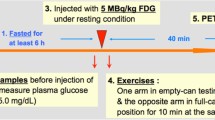Abstract
Purpose
Frozen shoulder is characterized by pain and reduced passive movement capability, and the diagnose is made clinically. However, pain is the major symptom in the first stage before stiffness occurs, and the condition can be mistaken for subacromial impingement. This study explored the possibility to use positron emission tomography/computed tomography (PET/CT) with a 18F Flour-Deoxy-Glucose (FDG) tracer in the diagnostic process.
Methods
Eleven patients with frozen shoulder and 9 patients with subacromial impingement received a 18F-FDG PET/CT scan before being treated surgically. During arthroscopy, the diagnoses were confirmed. Images were blindly analyzed visually by two nuclear medicine physicians. Also, semi-quantified analysis applying a set of standard regions was performed, and standard uptake value in both shoulder regions was recorded.
Results
Both the visual description of the pictures and the semi-quantified analysis generally showed increased FDG uptake in the affected shoulder regions of patients that had frozen shoulder and no uptake in patients with subacromial impingement. Kappa for interobserver agreement in the visual assessments was 0.74. Sensitivity was 92% and specificity 93% of the visual assessment, 77% and 93%, respectively, of the semi-quantified analyses, and by combining the two types of analyses sensitivity was 100% and specificity was 93% for the distinction between frozen shoulders and subacromial impingement/unaffected shoulders.
Conclusion
18F-FDG PET/CT seems to be a valid method to diagnose frozen shoulder. This is clinically relevant in diagnostically challenging cases, for instance in the first phase of frozen shoulder, which can be difficult to distinguish from subacromial impingement.
Level of evidence
II.



Similar content being viewed by others
Abbreviations
- FS:
-
Frozen shoulder
- SUV:
-
Standard uptake value
- SI:
-
Subacromial impingement
- VAS:
-
Visual Analog Scale
- ROI:
-
Region of interest
References
Cohen J (1960) A coefficient of agreement for nominal scales. Educ Psychol Meas 20(1):37–46
Diercks RL, Stevens M (2004) Gentle thawing of the frozen shoulder: a prospective study of supervised neglect vs intensive physical therapy in seventy-seven patients with frozen shoulder syndrome followed up for two years. J Shoulder Elbow Surg 13(5):499–502
Hajian-Tilaki K (2014) Sample size estimation in diagnostic test studies of biomedical informatics. J Biomed Inform 48:193–204
Hand GC, Athanasou NA, Matthews T, Carr AJ (2007) The pathology of frozen shoulder. J Bone Joint Surg Br 89(7):928–932
Jung JY, Jee WH, Chun HJ, Kim YS, Chung YG, Kim JM (2006) Adhesive capsulitis of the shoulder: evaluation with MR arthrography. Eur Radiol 16(4):791–796
du Kim H, Sung DH, Ga HY, Choi JY (2014) Metabolic patterns of the shoulder joint on (18)F-fluorodeoxyglucose positron emission tomography/computed tomography in adhesive capsulitis. Ann Nucl Med 28(2):136–144
Kubota K, Yamashita H, Mimori A (2017) Clinical value of FDG-PET/CT for the evaluation of rheumatic diseases: rheumatoid arthritis, polymyalgia rheumatica, and relapsing polychondritis. Semin Nucl Med 47(4):408–424
Maund E, Craig D, Suekarran S, Neilsen A, Wright K, Brealy S et al (2012) Management if frozen shoulder: a systematic review and cost-effectiveness analysis. Health Technol Assess 16(11):1–264
Moon YL, Lee SH, Park SY, Yu JC, Gorthi V (2010) Evaluation of shoulder disorders by 2-[F-18]-fluoro-2-deoxy-D-glucose positron emission tomography and computed tomography. Clin Orthop Surg 2(3):167–172
Neviaser AS, Hannafin JA (2010) Adhesive capsulitis: a review of current treatment. Am J Sports Med 38(11):2346–2356
Park JH, Lee YK, Kim DH, Kim SJ, Lee JH, Jeon TJ et al (2015) Usefulness of 18F-fluorodeoxyglucose positron emission tomography-computed tomography in monitoring adhesive capsulitis after breast cancer treatment. J Comput Assist Tomogr 39(3):349–355
Reeves B (1975) The natural history of the frozen shoulder syndrome. Scand J Rheumatol 4(4):193–196
Sridharan R, Engle MP, Garg N, Wei W, Amini B (2017) Focal uptake at the rotator interval or inferior capsule of shoulder on 18F-FDG PET/CT is associated with adhesive capsulitis. Skeletal Radiol 46(4):533–538
Won KS, Kim DH, Sung DH, Song BI, Kim HW, Song KS et al (2017) Clinical correlation of metabolic parameters on 18F-FDG PET/CT in idiopathic frozen shoulder. Ann Nucl Med 31(3):211–217
Funding
The study was funded by the Danish Rheumatism Association (Grant no. R101-A2009-B703).
Author information
Authors and Affiliations
Contributions
The study was planned by MRK, LF and MO. Patients were enrolled by MO and JRJ. The surgical findings were interpreted by MRK. PET/CT-scans were planned and interpreted by LDLD, LF and LS. Computer-assisted evaluations were made by LDLD. Data were interpreted by all authors. The manuscript was written by all authors.
Corresponding author
Ethics declarations
Conflict of interest
The authors declare that they have no conflict of interest.
Ethical approval
All procedures performed in studies involving human participants were in accordance with the ethical standards of the institutional and/or national research committee and with the 1964 Helsinki declaration and its later amendments or comparable ethical standards.
Additional information
Publisher's Note
Springer Nature remains neutral with regard to jurisdictional claims in published maps and institutional affiliations.
Rights and permissions
About this article
Cite this article
Duchstein, L.D.L., Jakobsen, J.R., Marker, L. et al. The role of 18F-FDG PET/CT in the diagnosis of frozen shoulder. Knee Surg Sports Traumatol Arthrosc 29, 210–215 (2021). https://doi.org/10.1007/s00167-020-05937-2
Received:
Accepted:
Published:
Issue Date:
DOI: https://doi.org/10.1007/s00167-020-05937-2




